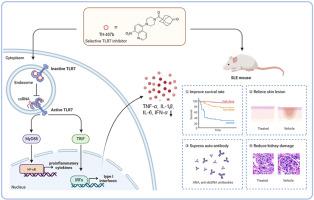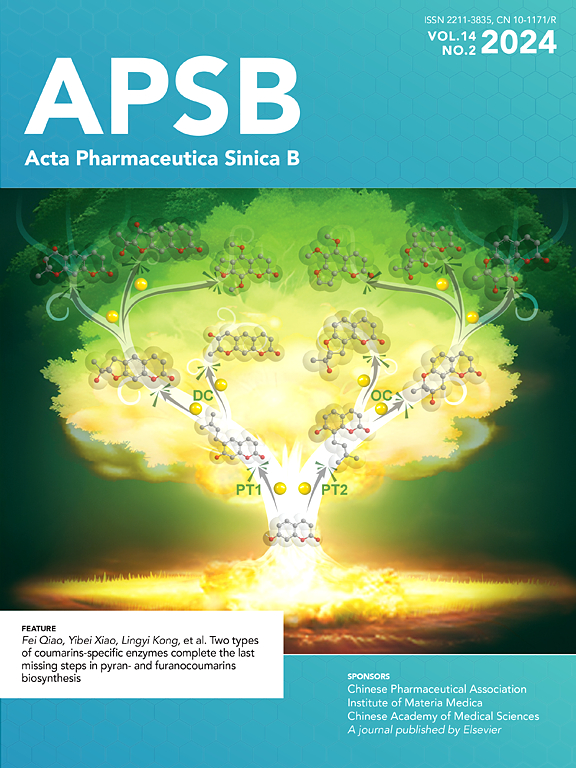以收费样受体 7 为靶点,开发系统性红斑狼疮的治疗策略
IF 14.7
1区 医学
Q1 PHARMACOLOGY & PHARMACY
引用次数: 0
摘要
内体 TLR(TLR3/7/8/9)是高度类似于各种病毒或细菌 RNA/DNA 分子模式的先天免疫传感器。其中,TLR7 尤其被认为是包括系统性红斑狼疮(SLE)在内的各种炎症性疾病和自身免疫性疾病的靶点;但文献中很少报道具有详细机制的小分子抑制剂。在此,我们报道了一种表征明确的人类 TLR7 特异性小分子抑制剂 TH-407b,它通过一种新的结合机制具有良好的效力和可忽略的细胞毒性。值得注意的是,TH-407b 不仅能在多种培养细胞系中有效抑制 TLR7 介导的促炎症信号传导,还能在系统性红斑狼疮患者的原代外周血单核细胞(PBMCs)中显示出强大的炎症抑制活性。此外,TH-407b 还具有显著疗效,可提高系统性红斑狼疮模型小鼠的存活率并改善其症状。为了从分子角度了解TH-407b衍生物的抑制机制,我们采用低温电子显微镜(cryo-EM)方法对TLR7/TH-407b复合物进行了结构分析。作为 TLR 家族的原子分辨率低温电子显微镜结构,它不仅对基于结构的药物设计具有重要价值,还为利用电子显微镜开发小蛋白的方法学提供了启示。值得注意的是,TH-407b 揭示了一种稳定 TLR7 静息/失活状态的抑制策略。这种静息状态可普遍适用于所有 TLR,从而为靶向这组重要的免疫受体提供了一种有用的方法。本文章由计算机程序翻译,如有差异,请以英文原文为准。

Targeting toll-like receptor 7 as a therapeutic development strategy for systemic lupus erythematosus
Endosomal TLRs (TLR3/7/8/9) are highly analogous innate immunity sensors for various viral or bacterial RNA/DNA molecular patterns. Among them, TLR7, in particular, has been suggested to be a target for various inflammatory disorders and autoimmune diseases including systemic lupus erythematosus (SLE); but few small-molecule inhibitors with elaborated mechanism have been reported in literature. Here, we reported a well-characterized human TLR7-specific small-molecule inhibitor, TH-407b, with promising potency and negligible cytotoxicity through a novel binding mechanism. Notably, TH-407b not only effectively inhibited TLR7-mediated pro-inflammatory signaling in a variety of cultured cell lines but also demonstrated potent inflammation suppressing activities in primary peripheral blood mononuclear cells (PBMCs) derived from SLE patients. Furthermore, TH-407b showed prominent efficacy in vivo, improved survival rate and ameliorated symptoms of SLE model mice. To obtain molecular insights into the TH-407b derivatives’ inhibition mechanism, we performed the structural analysis of TLR7/TH-407b complex using cryogenic electron microscopy (cryo-EM) method. As an atomistic resolution cryo-EM structure of the TLR family, it not only of value to facilitate structure-based drug design, but also shed light to methodology development of small proteins using EM. Significantly, TH-407b has unveiled an inhibition strategy for TLR7 via stabilizing its resting/inactivated state. Such a resting state could be generally applicable to all TLRs, rendering a useful method for targeting this group of important immunological receptors.
求助全文
通过发布文献求助,成功后即可免费获取论文全文。
去求助
来源期刊

Acta Pharmaceutica Sinica. B
Pharmacology, Toxicology and Pharmaceutics-General Pharmacology, Toxicology and Pharmaceutics
CiteScore
22.40
自引率
5.50%
发文量
1051
审稿时长
19 weeks
期刊介绍:
The Journal of the Institute of Materia Medica, Chinese Academy of Medical Sciences, and the Chinese Pharmaceutical Association oversees the peer review process for Acta Pharmaceutica Sinica. B (APSB).
Published monthly in English, APSB is dedicated to disseminating significant original research articles, rapid communications, and high-quality reviews that highlight recent advances across various pharmaceutical sciences domains. These encompass pharmacology, pharmaceutics, medicinal chemistry, natural products, pharmacognosy, pharmaceutical analysis, and pharmacokinetics.
A part of the Acta Pharmaceutica Sinica series, established in 1953 and indexed in prominent databases like Chemical Abstracts, Index Medicus, SciFinder Scholar, Biological Abstracts, International Pharmaceutical Abstracts, Cambridge Scientific Abstracts, and Current Bibliography on Science and Technology, APSB is sponsored by the Institute of Materia Medica, Chinese Academy of Medical Sciences, and the Chinese Pharmaceutical Association. Its production and hosting are facilitated by Elsevier B.V. This collaborative effort ensures APSB's commitment to delivering valuable contributions to the pharmaceutical sciences community.
 求助内容:
求助内容: 应助结果提醒方式:
应助结果提醒方式:


